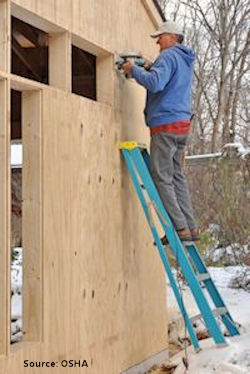Securing Ladders
There is a significant risk of falling if portable ladders are not safely positioned each time they are used. Unsecured ladders can slip or shift because of the weight load or lack of friction between the ladder and contact points. It is very easy to lose your balance while getting on or off an unsteady ladder. Be sure to evaluate the situation; do not use a ladder on slippery surfaces unless it is secured or has slip-resistant feet.
Inspecting Ladders
It is important to inspect the ladder before putting it to use. If the ladder is damaged, it must be removed from service and tagged until it is repaired or thrown away. Employees should conduct inspections for general ladder safety for all portable ladder types by checking the following:
- Ladders should not have any damage, lack of structural integrity, missing components or loose parts.
- Damaged or worn ladders should be destroyed.
- The steps or rungs must be tight and secured to the side rails.
- All hardware and fittings need to be properly and securely attached.
- Movable parts must be tested to see that they operate without binding or without too much free play.
- All labels should be intact and readable.
- Ladders should be free of oil, grease, or slippery materials.
- Ladder exposed to fire or strong chemicals should be discarded.
- All accessories such as leg levelers, paint shelves, stand-off shelves, etc. are in good condition.
- The ladder base should be placed on a secure and level footing. When necessary, ladder levelers should be used to achieve equal rail support on uneven surfaces.
- The ladder base must have the slip resistant material.
Knowledge Check Choose the best answer for the question.
2-2. There is a significant risk of falling if _____.
You forgot to answer the question!

